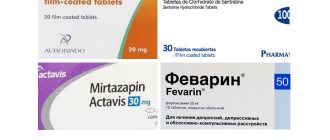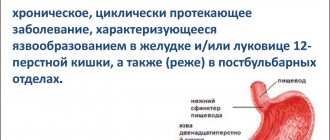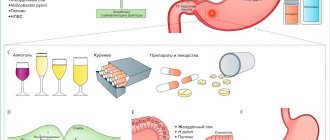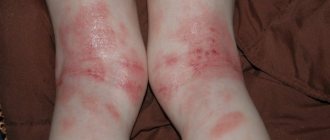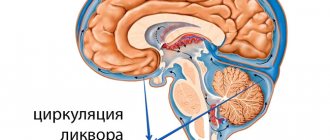Among diseases of the digestive system, stomach ulcers occupy a leading position. The causative agent is Helicobacter pylori, a pathogenic microorganism that penetrates the submucosal layer. Treatment is a set of measures, including medications for stomach ulcers, maintaining a certain diet, and using traditional medicine recipes. The main objective of the therapeutic course is to destroy Helicobacter, reduce acidity, eliminate heartburn and other unpleasant manifestations of the disease.
Ulcerative lesions of the stomach
A disease of the digestive organ that is chronic and manifests itself by the presence of small lesions on the mucous membrane in the form of ulcers and damage to the walls of the organ.
This type of disease tends to manifest itself in a chaotic manner and is most often found in patients over 20 years of age.
Unpleasant symptoms of the disease are formed as a result of spasms that compress the stomach and disrupt the digestion process.
The presence of an inflammatory process on the mucous membranes very often has an infectious type of occurrence, which can lead to the progression of the disease.
This type of disease does not go away on its own and requires the use of special treatment methods and dietary nutrition.
Treatment by surgery
If you follow the doctor's recommendations, you can cure an ulcer therapeutically, so surgical methods are extremely rarely resorted to. The list of indications for surgery includes:
- ulcer perforation - a breakthrough in the gastric wall, as a result of which the contents enter the abdominal cavity;
- stomach bleeding.
To eliminate the pathology, the surgeon removes the affected part of the wall.
the use of folk remedies in combination with drug therapy will speed up the healing process
Causes of ulcers
Factors that contribute to the manifestation of this type of disease can be various reasons. Experts say that each organism may have some individual factors that may increase the risk of developing an inflammatory process in the gastric mucosa.
However, the most common reasons are:
- long-term use of medications;
- stomach injuries;
- poor nutrition;
- bad habits such as drinking coffee and alcoholic beverages;
- observance of long hunger strikes;
- stressful situations;
- heredity;
- diseases such as diabetes, pancreatitis, and other types.
The causes of ulcers can be the consumption of foods containing large amounts of harmful compounds and food additives.
Frequent stressful situations can contribute to a lack of appetite, which has negative consequences for the digestive organs, most often manifested by ulcerative lesions of the stomach walls.
Pathogenesis
The normal functioning of the gastric mucosa occurs under the influence of two groups of factors on the mucosa:
- protective factors;
- aggressive, destructive factors.
Group 1 factors include: mucus produced by the gastric mucosa; this mucus prevents the reverse diffusion of protons to the mucosa.
Factors of the 2nd group include: gastric juice (containing hydrochloric acid and pepsin - an enzyme that digests protein compounds), which is an aggressive agent for cells and an infectious factor - the microbe Helicobacter pylori (in case of infection with it). The occurrence of a peptic ulcer occurs when the destructive effect of aggressive factors on the gastric mucosa begins to prevail over the effect of protective factors.
A significant number of gastric ulcers are associated with infection with the microorganism Helicobacter pylori, a spiral-shaped acidophilus bacterium that lives in the acidic contents of the stomach and in its mucous membrane. However, only a small number of infected Helicobacter pylori carriers develop clinically significant gastric or duodenal ulcers or hyperacid gastritis. The reasons that a minority of those infected with this microorganism get sick are not clear: apparently, the state of general and local immunity, nonspecific protective factors of the gastric mucosa (secretion of bicarbonates, protective mucus), initial (before infection) acidity and enzymatic activity of gastric contents are important. etc.
According to the latest updated data, 38% of gastric ulcers worldwide are associated with H. pylori infection. The second particular cause of gastric ulcers is the use of non-steroidal anti-inflammatory drugs. More rare causes include: adenocarcinoma, carcinoid, penetration of tumors of neighboring organs, sarcoma, leiomyoma, foreign bodies, diabetes mellitus, Crohn's disease, lymphoma, syphilis, tuberculosis, HIV infection.
The occurrence of stomach ulcers can also be caused by smoking, alcohol abuse (especially strong alcoholic drinks), coffee and other caffeine-containing drinks, neuropsychic stress, stress, depression, anxiety, when, as a result of increased tone of the vagus nerve, increased secretion of gastric juice occurs (so called “stress ulcer”), acute pain in severe injuries, burns, accompanied by the development of traumatic shock (the so-called “shock ulcer”), unsystematic nutrition, dry food, abuse of semi-finished products and concentrates, spices, sour, hot, peppery, salty, smoked , fried, too hot, too cold or otherwise thermally, chemically or mechanically irritating foods, carbonated drinks.
In some patients, exacerbation of symptoms is also caused by the consumption of large quantities of sweets or baked goods, apparently due to increased insulin secretion and a concomitant increase in acidity and pepsin secretion.
Ulcer symptoms
The formation of symptoms may appear as the disease progresses, and differ in varying degrees of intensity.
The most frequently reported unpleasant symptoms are:
- Pain in the stomach area can gradually move from the upper part of the organ to the lower. They can appear especially often before meals, after physical activity.
- Frequent heartburn, which manifests itself as a result of acidity disorders in the digestive organs;
- Lack of appetite.
- Nausea after eating, which leads to frequent cases where patients suffering from stomach ulcers induce artificial vomiting.
- Belching with an unpleasant bitter taste in the mouth.
- Increased flatulence.
- Feeling of heaviness in the stomach after eating food.
- Constipation.
Many patients who suffer from this type of disease note:
- increased sweating levels;
- the presence of a specific gray coating on the tongue;
- a feeling of heaviness in the stomach, which can sharply develop into pain symptoms, especially after the next portion of food;
- the presence of bloody discharge in the stool, such signs may indicate ulcers on the walls of the stomach that secrete a small amount of blood.
Lifestyle change
As a rule, the treatment method for gastritis is not based only on drug therapy and the use of folk remedies.
A major role in this process is also played by: adherence to a special diet and drinking regime, giving up bad habits, performing a set of exercises and the psychosomatics of the disease.
Eliminate bad habits
Alcohol for problems with the gastrointestinal tract has a detrimental effect on the walls of the stomach. Ethyl alcohol irritates the mucous membrane of the organ and increases the production of hydrochloric acid. Strong drinks dull the patient's sensitivity and relieve pain from gastritis for only a few hours. But then even a small dose of ethanol leads to an exacerbation of the disease and severe pain and cramps in the abdomen. Thus, the patient only makes things worse for himself and aggravates the situation.
Alcohol is eliminated from the body within 24 hours, and all this time it negatively affects the digestive system. Painkillers and antibiotics are strictly prohibited in such cases.
Smoking is considered the main enemy of the respiratory system, but some of the acrid smoke also enters the stomach. Puffing on cigarettes on an empty stomach is especially harmful to a diseased organ. Nicotine and tar, entering the gastrointestinal tract tissue, lead to vascular spasms, disrupting blood circulation in the organs. In addition, cigarettes for gastritis irritate the mucous membrane and impair the motility of the entire system.
Menu for gastrointestinal diseases
Poor and unhealthy diet are risk factors for the development of digestive diseases. Fasting, eating on the run and in a hurry, eating foods that damage the internal epithelium of the organ are the main provocateurs of exacerbation of gastritis and ulcers.
Gastroenterologists recommend dividing large portions of food into smaller portions and eating 4-5 times a day. In this case, the last meal should be at least 3 hours before bedtime. The patient should exclude from his diet foods containing synthetic and chemical ingredients. Replace processed, canned foods with fresh and natural ones. The gastritis diet consists of vegetables, fruits, proteins and healthy fats.
The menu for gastritis or ulcers should include dishes high in vitamins, minerals and antioxidants. Such products help cope with inflammation and are involved in the processes of restoration and scarring of damaged tissue. For gastrointestinal diseases it is useful to eat:
- dietary meat of chicken, beef, turkey and rabbit, steamed or boiled;
- flaxseed, sesame, olive oil;
- buckwheat, corn, oatmeal;
- soups with a second broth;
- baked, boiled vegetables;
- egg white;
- lean sea fish;
- drink goat milk.
A poor-quality daily menu leads to nutritional deficiencies, causes irritable stomach syndrome, and aggravates the patient’s general condition.
Diet for gastritis with insufficient secretion
The attending doctor should specify the daily diet of a patient with a hypoacid type of gastritis based on the results of laboratory and instrumental examinations.
The patient should eat easily digestible food, chewing it slowly and thoroughly. To reduce the load on the stomach, pureed dishes are recommended. It is forbidden to consume food that is too hot or cold, only warm food is allowed.
For gastritis with low acidity, it is allowed to eat:
- low-fat yogurt, kefir and cottage cheese;
- all types of porridges, except pearl barley;
- fruits and berries, even citrus fruits in small quantities;
- fish and meat: cod, pollock and pike perch, veal, rabbit, chicken and turkey fillet;
- vegetables: carrots, zucchini, cucumbers and broccoli, potatoes, sweet peppers.
In addition, it is necessary to remove from the diet foods that lead to exacerbation of the disease:
- smoked, spicy and pickled dishes;
- spices and sauces;
- pastries, pastries, cakes;
- canned food;
- sausages;
- fatty cheeses.
Drinking regime
For gastritis, you should drink 2 liters of still water per day. To reduce the load on the stomach and intestines, it is best to drink drinks 30 minutes before. before meals.
Cold or hot liquid should not be consumed. Coffee and strong tea can provoke an exacerbation of the disease, so it is better to avoid them.
Gastroenterologists recommend drinking alkaline water: Borjomi, Essentuki No. 4, Polyana Kvasova, Mirgorodskaya.
For inflammatory processes of the digestive system, compotes made from fresh berries, dried fruits and jelly are also useful.
Vegetable juices to treat stomach ulcers
The use of vegetable juices to eliminate the unpleasant symptoms of stomach ulcers can eliminate pain and improve the digestion process.
However, you should know that only freshly squeezed juices that have been stored for no more than 20 minutes are used.
Also of great importance is the correct choice of vegetables from which fresh juice is prepared and the presence of useful qualities to eliminate inflammation of the gastric mucosa.
The wrong choice of vegetable can lead to rapid progression of the disease and the appearance of other types of unpleasant symptoms.
The juice is prepared in small quantities immediately before use. This type of juice is used after meals ; it is strictly forbidden to use juice on an empty stomach; this can cause an increase in stomach acidity, which will lead to the formation of new inflamed areas.
Juices are used strictly in a certain quantity.
Recipes for juices useful for stomach ulcers
Experts recommend including the following types of fresh juices in your diet:
- Potato juice – it is recommended to peel the potato tubers and squeeze out the liquid using a juicer. In cases where such a device is not available, it is recommended to grate the tubers on a coarse grater and, using a piece of gauze folded in half, squeeze out the liquid. The resulting juice is recommended to be consumed three times a day in an amount of 100 mg. The duration of treatment is at least 10 days. The use of this drink helps normalize appetite and reduce acidity in the stomach. Potato juice also has a wound-healing effect and relieves unpleasant symptoms of pain and burning. To prepare the juice, only young potatoes are used that have not been subjected to long-term storage. The juice cannot be stored, as it can reduce its beneficial qualities and irritate the gastric mucosa. If drinking this drink causes nausea, the juice can be diluted with warm boiled water.
- Potato - carrot - using a mixture of carrot and potato juice allows you to saturate the body with useful vitamins, which have the property of accelerating the regeneration of damaged areas. It is recommended to use this type of juice after meals. To prepare, you need to squeeze out the juice of potatoes and peeled carrots in equal quantities. The liquids must be mixed, drink 100 g. after eating. It is recommended to drink this liquid in the morning and at lunch for 10 days. To achieve a more visible result, before each use, add a tablespoon of refined vegetable oil to the liquid.
- Beetroot juice – Vegetable juice made from beets helps improve the digestion process and increase the penetration of beneficial components. Beetroot juice is used very rarely on its own. To treat stomach ulcers, add 20 mg to potato or carrot juice. This type of mix allows you to eliminate unpleasant symptoms and improve intestinal function. For cooking, it is recommended to use young vegetables, which must be peeled and juiced. The duration of treatment with beet juice is no more than 5–6 days. It is recommended to use only raw vegetables; a product that has been subjected to heat treatment loses the necessary qualities for the treatment of ulcerative lesions.
In addition to the above vegetables, cabbage is widely used, which also has a healing effect on damage to the gastric mucosa.
Contraindications
The use of vegetable juices during the treatment of stomach ulcers may have the following contraindications:
- allergic sensitivity to vegetables;
- low stomach acidity;
- pregnancy (some types of vegetable juices can negatively affect the tone of the uterus);
- kidney disease (vegetable juice puts additional strain on the kidneys);
- gastritis.
The use of juice in the presence of contraindications can cause increased acidity and increase the symptoms of the disease.
Features of the approach
Some pathologies of the digestive system can be defeated forever by following the basic principles of combating them.
- Firstly, it is necessary to eliminate the aggressive effects of internal and external factors that cause destruction of the organ mucosa. Then gradually stabilize the production of gastric juice and normalize its concentration.
- Secondly, to restore damaged epithelial tissue, only effective drugs and folk remedies should be used.
As for chronic ailments, they require a more careful approach and long-term drug therapy. As a rule, the pathological process occurs without obvious symptoms and worsens regularly in the presence of provoking factors. It is no longer possible to get rid of it forever, but only long-term remission can be achieved.
An integrated approach to the treatment of gastrointestinal diseases ensures the patient’s complete recovery.
Acute and chronic gastritis
The acute course of the disease responds well to treatment. This type is characterized by pronounced features:
- pain and cramping in the abdomen;
- nausea and vomiting;
- weakness and dizziness;
- stool disorder.
Severe inflammation of the gastric mucosa occurs due to the aggressive influence of various factors on it. During therapy, the following recommendations must be followed:
- on the first day not to eat - to starve;
- drink warm teas, herbal infusions, mineral water;
- take painkillers and anti-inflammatory drugs as prescribed by your doctor;
- adhere to the medication regimen developed by the gastroenterologist;
- Follow a strict diet during treatment.
Full recovery occurs within a couple of weeks, provided that the patient is given proper treatment.
Chronic gastritis has some specific features. This type of disease is often caused by the bacterium Helicobacter pylori. If such a pathogen is detected during diagnosis, then treatment is primarily aimed at its destruction. To normalize acidity, the patient is prescribed special medications.
As a rule, after completion of therapy, the main symptoms of the disease no longer bother you. As for the disease itself, the stage of remission begins. Its duration depends on:
- ongoing preventive measures;
- following a special diet;
- timely elimination of physical and emotional stress.
Peptic ulcer
The main mechanism of this pathology is an imbalance between protective and aggressive factors in the mucous membrane of the stomach and duodenum. Failure of secretory and motor functions in the gastroduodenal zone leads to the formation of defects (ulcers) in the wall of the organ.
The treatment regimen is selected individually by the doctor, taking into account:
- phases of the disease;
- complications encountered;
- severity of the current;
- patient's condition;
- associated diseases.
Most often, therapy is carried out in two stages. In the acute period the following is carried out:
- selection of medications;
- there is an active impact on the causes of the disease;
- unpleasant symptoms are eliminated;
- The patient’s general well-being is stabilized.
During remission, the inflammatory process in the affected area is stopped, and the deformed area heals with the formation of a scar.
The second stage of treatment is aimed at preventing relapse. Preventive measures are actively carried out and continuous supportive care is provided. Thanks to modern techniques, it is possible to effectively eliminate the manifestations of the disease and prolong its remission for a long time.
According to the controversial opinion of doctors, it is possible to cure duodenal and gastric ulcers only when they are caused by Helicobacter pylori bacteria.
Reflux gastritis
The disease manifests itself as damage to the walls of the stomach caused by the ingress of duodenal contents into the organ. As a result, inflammatory processes begin in the epigastric region.
This condition can cause the development of ulcerative and erosive lesions of the gastric mucosa, as well as malignant tumors. With diffuse reflux, pathological disorders are characteristic of all walls of the organ.
Focal reflux gastritis affects only certain areas of the stomach. Whatever the disease, it is treated in traditional ways. Therapy is aimed at:
- restoration of the internal epithelium;
- elimination of the main symptoms;
- resumption of proper functioning of gastric motility and intestinal peristalsis;
- decrease in acidity level.
Treatment with propolis and butter
The use of propolis and butter allows you to achieve an anti-inflammatory and wound-healing effect.
Proper use of the product allows you to block the development of harmful organisms that destroy the mucous membrane.
Propolis restores damaged cells and activates natural regeneration processes.
The use of beekeeping products will make it possible to produce various tinctures and traditional medicine preparations to eliminate various types of diseases of the digestive system.
In combination with butter, it has a mild effect on the problem, making it suitable even for patients with an increased level of sensitivity.
Recipe for preparing a medicinal mixture
- You need to take one part propolis and 10 parts butter.
- Melt the ingredients in a water bath and take one teaspoon three times a day.
- Duration of treatment is up to 15 days.
- To achieve a higher medicinal quality, it is recommended to add hot oil to the propolis and simmer over low heat for 20–30 minutes, stirring constantly.
Propolis oil recipe
- To prepare the composition, you need to take 20 grams of propolis and 200 grams of butter. Using a water bath, melt the ingredients.
- Put the melted butter on the fire and slowly pour in the propolis. Stirring constantly, simmer for 30 minutes.
- It is recommended to cool the resulting composition to room temperature and use half a teaspoon three times a day for up to 20 days.
Contraindications
The use of such a mixture for the treatment of stomach ulcers is contraindicated in the following situations:
- individual intolerance to components;
- allergic reactions;
- age up to 3 years;
- liver disease.
Using the mixture may cause side symptoms such as nausea and vomiting. In case of such side effects, it is recommended to stop treatment.
Diet
Special requirements are put forward for food. It should spare the mucous membrane from mechanical and chemical damage and at the same time be complete. Meals should be fractional 5-6 times a day. All dishes must be chopped or consumed in liquid form, steamed or boiled, neither cold nor hot.
What foods can you eat if you have a stomach ulcer, and what can you not: list
| Foods you can eat | Products to exclude |
|
|
Turmeric
The use of turmeric can eliminate a large number of different diseases. The use of spices to treat stomach ulcers allows you to achieve an antibacterial effect and reduce acidity in the stomach.
It is recommended to use this type of spice with extreme caution, otherwise a complication may arise - rapid progression of the disease.
It is recommended to add 2 grams of dry powder to unsweetened tea and drink daily. Duration of treatment is up to 2 months.
The components of the substance allow you to restore damaged areas and prevent the further development of the disease.
Contraindications
The use of turmeric in the treatment of stomach ulcers is contraindicated in the following situations:
- individual intolerance to spices;
- allergic reactions;
- pregnancy;
- children under 6 years of age;
- internal bleeding;
- kidney and liver diseases;
- old age.
In case of urgent need for treatment in the presence of contraindications, the dosage of the substance is selected individually depending on the characteristics of the body.
Why and how does an ulcer develop?
| Helicobacter pylori infection | The main reason for the development of the disease. This spiral-shaped bacterium causes 45-75% of all cases of stomach ulcers. The source of infection is a sick person or a bacteria carrier. The microbe can be transmitted through:
|
| Due to taking medications | The second most common cause of pathology. These medications include:
|
| As a complication of various chronic diseases |
|
| As a result of acute diseases and conditions (so-called “stress ulcers”) |
|
| Social reasons |
|
Chaga mushroom
The use of the mushroom allows you to speed up the scarring process and reduce the inflammatory process in the digestive organs. It is recommended to use raw materials only from trees that do not have visible signs of disease.
After cutting the raw material, it is recommended to use the substance during the day, since a long stay of the growth outside the tree can lead to a decrease in its medicinal qualities.
The tanning components of birch wood have tanning properties and increase the rate of scarring of the area of ulcerative lesions.
The presence of a large number of useful microelements allows you to improve the digestion process and reduce the deposits of toxins and harmful wastes that interfere with the healing process.
Recipes
There are several recipes for preparing a medicinal mixture to eliminate stomach ulcers:
- Pour one spoonful of mushroom into a glass of warm water and leave for 24 hours. Then drain the liquid. Before eating, mix one egg with a tablespoon of alcohol and drink. After 1 drink two tablespoons of mushroom infusion. The duration of such treatment is up to 10 days.
- Pour a glass of chopped mushroom with water and add a glass of liquid honey. Leave for 3-4 days in a dark place. Strain and consume 50 grams daily. before eating. Duration of treatment is up to 20 days.
It is recommended to store the infusion in a tightly closed container in a cool place. If there is an unpleasant odor in the infusion, the use of such a drink is contraindicated.
Contraindications
The use of chaga mushroom is contraindicated in the following situations:
- sleep disturbance;
- nervous disorders;
- individual intolerance.
If it is necessary to use over the age of 3 years, a reduced dosage should be used.
Experts recommend consulting with your doctor before starting treatment for a stomach ulcer. Consumption in large quantities may cause nausea and vomiting.
Histamine receptor blockers
Continuing to talk about how to cure an ulcer, it is necessary to discuss histamine receptor blockers. These are products that are intended for acid-related gastrointestinal diseases.
They, like the drugs of the previous group, also reduce the production of hydrochloric acid. Only these medications do this by blocking histamine receptors. They are antisecretory drugs.
The most popular drugs belonging to this group are:
- "Ranitidine". 2nd generation medicine. Normalizes pH levels and minimizes the activity of digestive enzymes such as pepsin. Protects the mucous membrane and inhibits the synthesis of hydrochloric acid.
- "Nizatidine." Suppresses both excess and own acid synthesis. Positively affects pepsin activity and pH levels.
- "Roxatidine." In addition to the above actions, it normalizes the acid-base balance and suppresses the basal synthesis of gastric juice. The effect is noticeable just an hour after use.
- Famotidine. Provides the body with reliable protection against acetylcholine, histamine, gastrin and pepsin.
- "Cimetidine" The cheapest drug among those listed, as it belongs to the 1st generation. It has not yet lost its relevance. It has the same effect as the previously mentioned drugs, but its effect wears off after 6-8 hours.
St. John's wort
The use of St. John's wort has an analgesic effect in cases of stomach ulcers. In addition, the presence of tannins allows you to speed up the healing process of wounds and prevent further development of the disease.
The active components of the plant coat the walls of the stomach and reduce the secretion of juice in the stomach, thereby reducing acidity.
Proper use eliminates the development of microorganisms that disrupt the normal balance in the digestive organs and complicate the process of digesting food.
Use with caution if the body is hypersensitive; use in large quantities may increase the manifestation of symptoms of the disease.
Recipes
To restore the mucous membrane of the digestive organs, the following methods are used:
- Pour a pinch of herb with a glass of boiling water and leave for 2 hours. Use three tablespoons before meals in the morning and evening. Duration 2 weeks. If necessary, treatment can be repeated after a 7-day break.
- Oil infusion . Two plants without roots must be crushed using a meat grinder and placed in a 1 liter glass container. Pour in vegetable oil and leave for 7–10 days. Then strain and consume 2 tablespoons twice a day for 20 days. If the use of such a composition causes a feeling of vomiting, it is necessary to dilute the composition with water or use a small piece of stale bread, onto which oil is applied and eaten on an empty stomach. The resulting oil infusion is stored in a glass container in a cool place. May form a slight sediment. In this case, it is necessary to thoroughly shake the oil composition before use.
Contraindications
St. John's wort, when used incorrectly, has the ability to cause toxic effects and negatively affect health.
Contraindicated in the following situations:
- epilepsy;
- pregnancy;
- HIV infection;
- use of sedative-type drugs;
- individual sensitivity;
- alcoholism.
During the treatment period, it is recommended to reduce the patient’s exposure to direct sunlight, otherwise burns and increased pigmentation may occur.
Indications for surgery
Sometimes an ulcer cannot be eliminated with conservative treatment alone. In this case, surgery is indicated for the patient. The surgeon's intervention can be carried out only if there are specific indications. In particular, if drug treatment does not give the desired results, as well as if there is a high risk of complications when taking medications.
Among the absolute indications are:
- Perforation of the ulcer;
- Development of bleeding;
- Third degree stenosis;
- Transformation of an ulcerative process into a cancerous one.
Doctors include relative indications:
- Penetration process;
- Deformation of the stomach due to formed scars;
- Increased incidence of relapse of the disease;
- Second degree stenosis;
- Callous ulcer;
- Non-healing of the ulcer over a long period of time.
If there are indications for surgery, you should not avoid it or delay it. Keep in mind that any elective operation carries fewer risks than an emergency one. In addition, emergency intervention is not always effective, and complications definitely pose a threat to the life and health of the patient. Therefore, if the doctor says that surgical intervention is necessary, you should not continue treatment with conservative means.
Mumiyo
The mummy substance is used to activate the processes of restoration of damaged tissues. The active components of the substance activate the protective functions of the immune system, which also contributes to the rapid elimination of the disease. Regular use reduces pain and heaviness in the stomach.
Proper use increases gastric motility, thereby improving the digestion process.
Recipes
Use of mumiyo to eliminate damage to the gastric mucosa:
- Dissolve 0.2 grams of mumiyo in 50 grams of warm milk. Stir thoroughly and consume half an hour before meals. The duration of treatment is at least 20 days. The prepared solution of the drug in milk cannot be stored; to achieve the highest level of results, it is recommended to use medium-fat pasteurized milk.
- Add 2 grams of the substance to a glass of water and stir well. Insist for a day. Take a teaspoon daily once a day before meals. The duration of treatment is at least 15 days. Store the resulting liquid in a tightly closed glass container in the refrigerator for no more than 2 days.
If repeated treatment is necessary, it is recommended to take a break of at least 15 days . In cases where the use of the traditional method causes nausea, treatment with the substance for stomach ulcers is recommended to be stopped.
Contraindications
The substance mumiyo is contraindicated:
- children's age 6 years;
- individual intolerance;
- oncological diseases.
Individual reactions of the body to the medicinal substance may be observed; a sensitivity test should be performed before starting treatment.
Classification
By location, the following are distinguished:
stomach ulcers:
- cardiac department;
- ulcer of the body of the stomach;
- antrum;
- pyloric canal;
duodenal ulcers (localized in the duodenum):
- bulb ulcer;
- subbulb ulcer;
combined ulcers (simultaneously affecting both the stomach and duodenum).
Clinical manifestations:
- Acute - develops quickly and affects large parts.
- Chronic - develops gradually, remission can last a very long time.
To size:
- Small (less than 5 mm)
- Medium (5 - 10 mm)
- Large (11-30 mm)
- Giant (more than 30 mm).
With the flow:
- Latent (atypical) - neurovegetative changes are pronounced (often observed in adolescence)
- Mild (rarely recurrent) - very mild with little pain (mainly in young women)
- Moderate severity - recurs 1 - 2 times a year
- Severe - continuous relapse, which is expressed by weight loss, metabolic disorders and various complications
Calendula
The use of calendula in the treatment of stomach ulcers allows you to achieve an antibacterial effect, which reduces the inflammatory process and restores damaged areas of the stomach walls.
The presence of essential oils improves the functioning of the digestive organs and reduces the secretion of hydrochloric acid, which causes damage to the gastric mucosa.
The healing properties of calendula have a wound healing effect, which increases the rate of restoration of damaged cells and scarring of ulcerative lesions.
Recipes
The use of calendula flowers in the treatment of ulcerative lesions of the gastric mucosa is used in various herbal preparations.
However, the most commonly used ones should be highlighted:
- Pour a spoonful of calendula flowers into a glass of refined oil and place in a water bath for 2 hours. Strain, take the resulting liquid one teaspoon twice a day for 14 days.
- In a glass of warm milk you need to add a tablespoon of oil infused with calendula flowers and a tablespoon of liquid honey. Use daily after waking up. Duration of treatment is up to 10 days.
Calendula can have a toxic effect, so it is not recommended to increase the dosage of the plant indicated in recipes.
Contraindications
The use of a medicinal plant has a wide spectrum of action, however, in some cases, treatment with the plant is contraindicated, these include:
- increased sensitivity to the plant;
- allergic reactions;
- age up to 12 years;
- pregnancy (has the property of increasing the tone of the uterus, which leads to premature birth);
- Internal bleeding.
The medicinal plant can negatively affect the health of the heart and blood vessels.
Diagnostics
To diagnose a gastric ulcer, it is very important to carefully collect anamnesis (patient complaints, pain associated with eating, hereditary predisposition, seasonality).
During an objective examination of the patient, palpation of the abdomen reveals tension in the abdominal wall in the epigastric region and in the left hypochondrium.
To accurately confirm gastric ulcer, the following instrumental research methods are used:
- Blood test for the content of Helicobacter Pylori antibodies.
- Determination of the acidity of gastric juice (PH - metria), using a probe inserted into the stomach, a portion of gastric juice is taken and its acidity is examined, which depends on the content of hydrochloric acid.
- X-ray examination of the stomach reveals the following signs characteristic of a stomach ulcer:
- niche symptom – retention of contrast agent in the area of the gastric mucosal defect;
- ulcer shaft - characterizes the area of inflammation around the ulcer;
- cicatricial-ulcerative deformation of the gastric wall, characterized by the direction of the folds of the mucous membrane around the ulcer, in the form of a star;
- index finger symptom, characterized by retraction of the gastric mucosa on the opposite side to the ulcer;
- pylorospasm, spasmed pyloric sphincter does not allow contrast agent to pass through;
- accelerated and delayed evacuation of contrast agent from the stomach;
- Detects the presence of possible complications (ulcer perforation, penetration, ulcerative stenosis).
- Endoscopic examination (fibrogastroduodenoscopy), this method consists of examining the gastric mucosa using a fibrogastroduodenoscope. This research method determines the location of the ulcer, its exact size, and possible complications (including bleeding from the ulcer).
- Microscopic examination of a biopsy of the gastric mucosa taken during fibrogastroduodenoscopy for the presence of Helicobacter Pylori.
Stomach ulcer: photo
Plantain in the treatment of stomach ulcers
The use of plantain in the treatment of various diseases, including stomach ulcers, is widely used in traditional medicine. The medicinal plant has antiseptic and anti-inflammatory properties.
Use for the treatment of digestive organs allows you to reduce gastric secretion and restore damaged cells on the organ mucosa.
The leaves of the plant contain components that accelerate cholesterol metabolism, thereby improving the patient's condition with peptic ulcers; plantain has powerful analgesic properties, can reduce the development of the disease and block bleeding.
Plants that grow away from roadways and without visible symptoms of damage are used.
Recipes
There are several ways to use plantain to treat stomach ulcers:
- Making tea . A small amount of the plant should be poured with boiling water and consumed instead of tea twice a day. Duration of use until the unpleasant symptoms disappear.
- Plantain tincture . You need to add one spoon of herb to a glass of boiling water. Leave for 20 minutes. Strain the infusion and consume 100 ml daily in the morning.
- Plant juice . To achieve more visible results, it is recommended to use fresh plant juice. To prepare, you need to chop the leaves and squeeze out the liquid. Take one teaspoon once a day on an empty stomach, gradually increasing the dose to 50 grams; the duration of treatment using the traditional method is determined individually for each patient, depending on the state of health.
- Infusion from seeds . For preparation, you need to use the seeds of the plant. Pour one tablespoon of boiling water. Take a teaspoon three times a day. The course of application is no more than 15 days.
- Fresh plants - recommended for use in case of exacerbation of the unpleasant symptom of pain in the abdominal area. It is recommended to chew half a plantain leaf. This type of procedure can be carried out every day, treating the plant with clean water before use. The substance is recommended to be used with caution; it may cause adverse reactions in the form of an allergic rash.
Contraindications
The use of plantain has virtually no contraindications. Not used in case of individual intolerance. Use with caution in patients over 3 years of age.
Drug therapy
If a person has an ulcer, it is necessary to treat the stomach with medications. The duration of the course depends on the degree of development of the disease, but the symptoms begin to subside after a few days.
Only a doctor should prescribe medications based on test results. Prescribed medications may belong to different drug groups:
- Antibiotics. If the cause of the disease is the bacterium Helicobacter pylori, then the main task is to neutralize the pathogen. The most effective remedies: Tetracycline, Clarithromycin, Metronidazole and Amoxicillin. With their help you can quickly get rid of ulcers.
- Antacids. Such medications have the ability to protect the gastric mucosa from negative effects, remove toxins and reduce enzyme activity. Among the most popular antacids are Almagel, sodium bicarbonate, Gastal, Phosphalugel and Maalox.
- H2-antihistamines. Under the influence of such drugs, gastric juice begins to be produced in smaller quantities, due to which inflammatory processes are reduced. Doctors often prescribe Nizatidine, Ranitidine, Quamatel or Cimetidine.
- Antispasmodics. Such drugs are prescribed to relieve symptoms and treat pain. The patients' condition improves after taking Dibazol, Papaverine, Halidor and No-shpa tablets.
- Anticholinergics. Aimed at relaxing the stomach muscles and reducing juice production. Among them are Platifillin, Etpenal, Gastrocepin and Metacin.
- Antiemetics. Facilitate the general condition of the patient. Doctors recommend Cerucal or Motilium.
- Reparants. Such medications accelerate the healing of ulcerative lesions and restore blood circulation. Help with ulcers is provided by Methyluracil, Solcoseryl and Amigluracil.
The pharmaceutical industry produces a wide range of drugs that have a therapeutic effect on stomach ulcers
Treatment regimen
In most cases, complex treatment of the stomach is prescribed. The course of therapy includes several methods:
- Medication method. With its help, the cause of the disease is eliminated and the symptoms are relieved.
- Operation. It is prescribed in severe cases.
- Using folk recipes for ulcers.
Diet for treating ulcers
Following a diet and proper nutrition can relieve stress on the stomach and speed up recovery. In addition, the absence of harmful foods has a positive effect on the entire body.
The use of honey in the treatment of stomach ulcers
A large number of different recipes using honey are available in folk medicine. Honey has unique antiseptic abilities, and the beekeeping product quickly relieves inflammation and activates the regeneration process of damaged cells.
Honey is used not only to treat the digestive system, but also to facilitate the digestion of food and normalize daily bowel movements, which is also important in the treatment of ulcerative lesions of the stomach walls.
Recipes
The use of honey in folk medicine for the treatment of stomach ulcers is recommended according to the following recipes:
- Walnuts and honey . To prepare this recipe, you need to prepare the following ingredients: 200 grams of honey, a glass of chopped walnuts. A stick of butter 200 grams and one medium carrot. Melt the butter in a water bath, add finely grated carrots, nuts and honey and, using a wooden spoon, grind the resulting mass into a homogeneous mixture. Take 1 tablespoon three times a day on an empty stomach. Duration of treatment is up to 21 days.
- Curdled milk with honey Mix 1.5 liters of curdled milk with a glass of honey and consume 200 grams three times a day on an empty stomach, the duration of use is until the symptoms of the disease disappear.
- Honey and lemon . Squeeze the juice of one lemon, add a glass of honey and a glass of refined vegetable oil. Take one tablespoon three times a day. The course of treatment is observed for at least 30 days.
The resulting composition containing honey is stored in a glass container, tightly closed in the refrigerator.
Contraindications
Honey should be used with caution for people with diabetes. Use is contraindicated in case of allergic reactions to bee products.
Prevention of chronic diseases of the gastrointestinal tract
How to permanently cure gastritis, ulcers and other inflammations and damage to the walls of internal organs? Of course, you need to adhere to a number of recommendations throughout your life, and not just “when you get it”:
- in order to reduce the risk of contracting Helicobacter pylori infection, adhere to the rules of personal hygiene;
- follow a diet: the diet should be varied, and it is better to always eat at the same time. Stick to a pattern of frequent split meals (4-5 times a day);
- marinades, pickles, smoked meats, canned foods, fatty and fried foods do not have the most beneficial effect on the condition of the mucous membranes of internal organs, and, as a rule, there is no benefit from them, so it is better to refrain from consuming them;
- smoking very often provokes the development of peptic ulcers, and alcohol is a direct enemy of your health, so giving up cigarettes and alcohol would be the best solution;
- do not practice self-administration of medications: medications may have side effects that you may not immediately notice;
- If possible, avoid negative emotions and stressful situations;
- learn to relax, devote enough time to rest.
Recipes for folk remedies are suitable only as an addition to the main treatment. Do not forget about this and listen, first of all, to the advice of doctors. And then your health will certainly improve!
The use of aloe in the treatment of stomach ulcers
The use of aloe in folk medicine has been used for a long time. The plant has many useful qualities not only for eliminating ulcers, but also for general strengthening of the body.
- The beneficial vitamins contained in the leaves of the plant activate the process of restoration of damaged areas in the digestive organs. The ability to eliminate inflammation and block the development of harmful microorganisms allows you to reduce the likelihood of further development of the disease.
- The lower leaves of the plant are most often used. Aloe must be at least 3 years old. Young leaves do not have such a strong effect and may not have the desired effect on the body.
- Before cutting the leaves, it is recommended not to water the plant for a while. Cut leaves should be wrapped in paper and refrigerated for 3-4 days.
- Then cut off the peel and pass the aloe through a meat grinder. There are a large number of traditional medicine methods for preparing compositions for treating the stomach.
However, the most commonly used is aloe with honey and walnuts . To prepare the composition, it is recommended to mix the ingredients in equal quantities and place in a glass container. Use two teaspoons on an empty stomach three times a day. Duration of treatment until the unpleasant symptoms disappear.
Contraindications
The aloe plant is contraindicated for patients under 3 years of age and for those with individual sensitivity to its constituent components.
Antacids
These drugs help cope with any acid-related gastrointestinal diseases, since they neutralize hydrochloric acid, which is a component of gastric juice.
An antacid medication is a medicine for ulcers, used as an antiseptic or as an absorbent, enveloping agent. Each drug belonging to this subgroup performs a number of actions:
- Protects the mucous membrane from the effects of aggressive factors.
- Removes toxic substances.
- Softens inflammatory processes.
- Reduces the activity of enzymes and hydrochloric acid, due to which the mucous membrane is corroded.
Popular drugs are such drugs as Almagel, Maalox, Phosphalugel, Gastal, and also sodium bicarbonate. To improve absorption, you can take Festal.
The use of these products is much more appropriate than the use of polysorb or activated carbon. Having greater efficiency, they have a gentle effect on the body.
Dairy
The use of dairy products for stomach ulcers can reduce discomfort and acidity. Dairy products contain a large number of useful micro and macroelements, which alleviate the course of the disease and reduce the unpleasant symptoms of pain and burning.
- Daily use of dairy products allows you to accelerate the process of scarring of stomach ulcers, which leads to its gradual elimination.
- Milk has the ability to coat mucous membranes and prevent the harmful effects of stomach acids.
- Traditional medicine methods recommend using milk and honey daily on an empty stomach to eliminate stomach ulcers.
- Low-fat, non-sour kefir is also widely used. Which speeds up the process of digesting food and makes it easier to go to the toilet every day.
In case of exacerbation of a stomach ulcer, accompanied by severe attacks of pain, the use of fermented milk products, which can aggravate the course of the disease.
For cases where the disease does not have acute symptoms of pain, it is recommended to introduce porridge with milk and low-fat dairy products into the daily diet.
Such methods of influencing the disease are not recommended for use in the presence of individual lactose intolerance.
Manifestation of peptic ulcer at different stages
| Initial stage. | Paroxysmal pain in the navel area. They can intensify on an “empty” stomach or at night. During an exacerbation, a person cannot even move. The pressure drops sharply, the face turns pale, cold sweat appears, and the lips turn blue. When you probe the stomach area with your fingers, severe and intense pain appears. |
| Second stage. | With this degree of damage, the pain suddenly disappears. The temperature begins to rise rapidly. The heart rate increases, constipation occurs, and the mouth becomes dry. Additionally, bloating appears. |
| Third stage. | is fraught with the occurrence of perforation of an ulcer. If no immediate measures are taken, peritonitis may occur. Intense toxicity is observed, and health quickly deteriorates. |
In most cases, the pathology develops against the background of other gastrointestinal diseases (gastritis, wall erosion), so a person must be very attentive to the signals that the body sends. You should schedule an appointment if you experience the following symptoms:
- decreased appetite;
- increased gas formation;
- vomiting, belching, nausea;
- weight loss;
- heaviness after eating, feeling of fullness;
- constipation;
- stomach ache;
- whitish coating on the tongue;
- increased sweating.
Other methods of traditional treatment
A huge number of different methods of alternative medicine are used to eliminate stomach ulcers. The effect of this treatment is aimed at eliminating pain and discomfort.
Most commonly used:
- Pumpkin seeds . A decoction of pumpkin seeds reduces stomach acidity and eliminates the unpleasant symptoms of pain and heaviness in the stomach. It is recommended to grind a handful of seeds with peel and pour a liter of boiling water. Leave for several hours. Use instead of tea. Duration of therapy is up to 15 days. Not recommended during pregnancy, as the seeds can cause a laxative effect on the body and increase the tone of the uterus.
- Flaxseeds. The benefits of flaxseed are used to eliminate various types of diseases. The use of flax for the treatment of ulcerative lesions of the walls of the digestive organs allows you to envelop the damaged areas, reduce the effect of stomach acids, thereby increasing the scarring of ulcers. It is recommended to pour a spoonful of flaxseed into a glass of boiling water and leave for several hours. The substance will become viscous. Use this mixture 50 grams three times a day. Duration of therapy is up to 15 days.
- Chamomile decoction. Helps reduce inflammation and improve the patient's well-being. To obtain the desired result, it is recommended to use the traditional treatment method for a long time. To prepare it, it is recommended to add a tablespoon of chamomile flowers to a glass of boiling water. Leave for 20 minutes, use three times a day instead of tea. Duration of treatment is at least 3–5 months.
- Pomegranate. It is recommended to use pomegranate peel to treat stomach ulcers. Pomegranate peel contains useful substances that have a healing effect on the problem area of the stomach. It is recommended to peel the pomegranate peel from the white coating and dry it in the sun or in the microwave. Grind the resulting peels. To prepare the infusion, it is recommended to pour half a liter of boiled water over a tablespoon of peel and leave for two hours. Strain and consume 50 grams twice a day. on empty stomach. Duration of treatment is up to 10 days. The infusion has tanning components, which blocks the further development of the disease.
The use of alternative treatment methods can reduce the intensity of the disease and improve the digestion process. However, before starting to use any method of alternative treatment, it is recommended to conduct a sensitivity test to the components of the recipe and consult with your doctor.
Antibacterial drugs
Now you can talk in detail about how to cure an ulcer. Complex therapy cannot do without taking antimicrobial agents. Their task is to eliminate the notorious helicobacter pylori, which is the causative agent of ulcers.
The drugs are prescribed in the form of injections or tablets. The most popular are Clarithromycin, Tetracycline and Erythromycin.
The doctor may also prescribe Trichopolum, which has not only an antimicrobial, but also an antiprotozoal effect.
Antibacterial medicine for ulcers must be selected with caution. Each drug has its own purpose. "Clarithromycin", for example, is prescribed in unadvanced cases, as well as for the purpose of prevention.
Amoxicillin is considered particularly effective. This is a penicillin drug that is resistant to the destructive effects of enzymes. That is why it is absorbed by the body by more than 90%.
Prevention of stomach ulcers
To reduce the risk of developing a stomach ulcer, it is necessary to perform the following prevention methods, which include:
- Adequate sleep is necessary to increase the level of natural protective functions of the body.
- Proper nutrition . The daily diet should include the required amount of healthy vitamins and minerals. Reduce consumption of fatty, spicy and salty foods.
- Avoid junk food . It is recommended to eliminate from the diet foods such as burgers, chips, and smoked meats, which contain a large amount of food additives and can destroy the structure of the mucous membrane.
- Eat small portions , but often.
- Avoid long fasts . During this period, the secretion of hydrochloric acid in the digestive organs increases, which tends to destroy the structure of stomach cells.
- Do not abuse alcoholic beverages.
- Avoid stressful situations.
Compliance with preventive measures will reduce the likelihood of developing a disease such as a stomach ulcer. If the first signs of the disease appear, it is recommended to consult a specialist to identify the stage of the disease.
The essence of the disease
Modern medicine often encounters cases of damage to the mucous membrane of the digestive organs in patients. The inflammatory process (gastritis) develops under the influence of various causes:
- infection of the body with bacteria Helicobacter pylori;
- uncontrolled use of certain medications (hormones, cytostatics, non-steroidal anti-inflammatory drugs);
- living under constant stress; physical and psychological stress; lack of regular rest;
- non-compliance with the rules of a balanced diet (irregular meals, passion for spicy, fried and salty foods, smoked foods);
- abuse of cigarettes, alcohol and strong coffee;
- genetic predisposition.
The risk group includes men. They suffer from these diseases almost 5 times more often than the fair sex.
Failure to promptly eliminate these causes leads to inflammation becoming chronic. The weakened protective lining of the stomach under the influence of hydrochloric acid is damaged more and more deeply, up to the damage to the muscle layer.
Not only is digestive function disrupted, but there is also a danger of breaking through the wall of the organ and penetration of gastric contents into the abdominal cavity. This leads to serious infection, shock and can cost the patient his life.
Also, one of the serious consequences of an ulcer is internal bleeding. Intense blood loss without immediate surgical intervention can lead to death.
Reviews of treatment with folk remedies
The appearance of a stomach ulcer can cause a lack of appetite and severe pain after eating food. Many people who suffer from this type of disease, over time, begin to sharply reduce their weight and acquire a feeling of fear before eating food again.
Therefore, experts recommend not delaying the necessary treatment of the disease and promptly addressing the problem with all available methods.
Marina Maksimova
Gastroenterologist, Candidate of Medical Sciences and editor of articles at gastro911.com. For more than 10 years I have been helping to recover from gastrointestinal diseases.
Signs of pathology
Among the main manifestations of the disease are:
- pain in the upper abdomen, between the navel and sternum, usually on the left side; the nature of the pain is aching or, conversely, sharp, cutting, cramping;
- pain appears within an hour after eating or on an empty stomach (so-called “hunger pain”) and may subside after taking painkillers or soda;
- heartburn, feeling of bloating, fullness of the stomach;
- belching with a sour taste;
- nausea, in some cases - vomiting, which relieves pain;
- loss of appetite due to psychological reasons (fear of pain); as a result, weight loss;
- increased discomfort in the autumn and spring periods.
If you notice these symptoms, you must urgently consult a doctor, first a therapist, who will recommend you to attend a consultation with a specialist and undergo the necessary instrumental and laboratory tests.
The answer to the question of how to treat an illness will directly depend on the reasons that provoked the disorder. The treatment course is prescribed by a gastroenterologist.
Proton pump inhibitors
These drugs are also antisecretory. But they block the proton pump - H/K-ATPase. This is the name of the membrane integral protein.
And if a person has been diagnosed with a peptic ulcer of the stomach and duodenum, he cannot do without taking these medications. The following medications are usually prescribed:
- Lansoprazole. The drug inhibits the production of hydrochloric acid immediately before its release into the gastric cavity.
- "Omeprazole." Inhibits the activity of an enzyme such as H+-K+-ATPase.
- "Rabeprazole". In addition to the above actions, it also destroys the notorious bacteria that cause ulcers.
- "Esomeprazole." This is a dextrorotatory isomer of omeprazole, which also inhibits the synthesis of hydrochloric acid before its release into the stomach.
It is important to note that the listed drugs are especially effective for duodenal ulcers. Omeprazole is often prescribed to prevent this disease.




